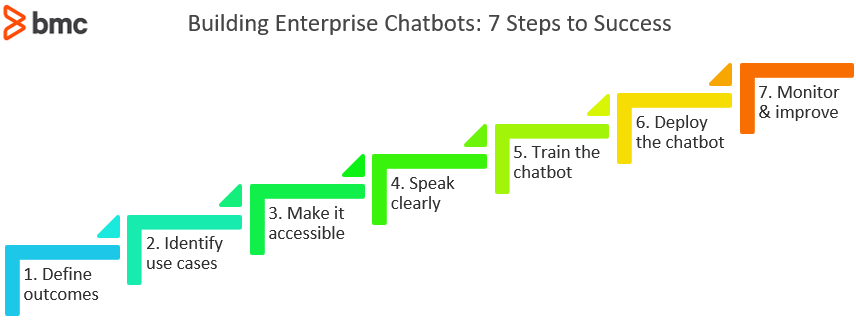Recently, I was using a company’s chatbot to get an answer about their software. It was a complex scenario where I thought direct contact with the company’s support team would be easier than googling a solution.
Their chatbot connected within seconds. I asked my question in natural language: that uncertain description of trying to say what is wrong, even though I have no access to the precise language of what was occurring. Fortunately, their chatbot picked up on exactly what I was talking about and gave me instructions to troubleshoot the error.
It was so easy I actually left the browser window open so I could use it on far simpler questions—instead of using Google.
Accessibility, simplicity, and effective communication are at the heart of a good chatbot experience. Enterprise chatbots help to deliver the intuitive, seamless, omni-channel experiences today’s employees expect while improving IT speed, efficiency, and productivity. Chatbots reduce cost, improve satisfaction, and free resources for higher priorities like multi-cloud management—helping the organization adapt to the dynamic demands of digital business.
As with adopting and implementing any new technology, it’s important to go about implementing your chatbot the right way to get the best results. Here are eight operational best practices—broken into three phases—that we’ve developed to ensure the success of your implementation.
Phase 1: Chatbot planning
1. Define business outcomes & success
Before it begins, make sure you’ve identified measurable, quantifiable business outcomes to track from beginning to end.
You could create a great, friendly chatbot that engages users for hours, but if its function was to get users access to information and fade into the background so the user could get back to their life, then the chatbot has failed.
Every successful IT project begins with a clear business case. What are the metrics you’re seeking to improve with your chatbot? How will you measure the success of your implementation? Possible success outcomes are:
- Reduce costs
- Process improvements
- Process efficiencies
- Transform user experience
- Improve user productivity
- Accelerate resolution
- Boost productivity or accuracy of IT staff
2. Identify use cases
To set the scope for your implementation, first decide what you want the chatbot to help you with, and how it will do so. It’s best to start small, with 5-10 key services that are:
- Frequently requested so you can achieve both high visibility and high impact
- Easily automated so you can gain skills and experience for more complex use cases to follow
- Conversational as suits the natural language nature of chatbot interaction
- Pervasive so you can drive transformation broadly across your organization and user base
Make sure the services you select have up-to-date content and questions in your service catalog, including accurate knowledge for less frequent requests.
(Understand natural language in our NLP vs NLU primer.)
3. Make it accessible
Put your chatbot where your users need it. Consider who your users are and the channels they’re already using. The goal is to make it accessible.
Once you’ve chosen where this is, tell them where it is. Let them know about the new service and what it is used for. Then, demonstrate some examples of the chatbot in use!
4. Design to communicate
The chatbot needs to communicate. There is a lot of developed theory around what makes chatbots easy to use and good to interact with that you can pull from and don’t need to feel like you’re reinventing the wheel.
Search terms for that information include:
- Chatbot conversation designers
- Chat UX
Anyone working with chatbots says their success depends on how well they were planned and designed, so these Phase 1 steps are important.
Let’s look at a few takeaways from chatbot communication design:
Design the dialogue flow. A conversation can go in many direction. That means the chatbot conversation needs to be carefully planned in much the same way that web designers plan how people will travel through their websites.
- What is the basic information to present, that can lead to deeper information?
- What is the conversation journey you wish to take the user on?
- How do they enter the conversation? How do they leave it?
Create a persona. People act with personalities and you should create one for your conversation experience. The persona can steer the language that presents the message. Based on the persona, the welcome message could vary. Consider the differences:
- “Howdy y’all!”
- “What may I do for you today?”
- “VA Roger reporting for duty.”
Tighten message length. Say what needs to be said and be done. Bullet points and numbered lists convey more information in less words.
A huge part of unsuccessful chatbots? When the user tries to go off-script. The tighter you keep the message, the narrower the channel of communication is, and the better you lead your user through a dialogue.
Provide user response options. You should prompt a user with accepted prompts. You train them to know what inquiries are appropriate for your system.
This is sometimes overlooked, and/or undervalued, but this same communication works well in other domains as well. Comedians are more successful when they queue the audience to laugh, and street performers are more successful when they give the audience optional answers after they ask a question.
This works because it puts constraints around the user response by setting an expectation of what kinds of responses are reasonable.
Build in feedback loops. Remember, communication is a two-way street—use employee feedback to assess and improve the effectiveness of your messaging.
(Read more about feedback loops.)
See how BMC engineers build chatbots:
Phase 2: Implement the chat agent
5. Train your chatbots
There are tools out there to design chatbots, like Voiceflow, and there are services to actually create a chat agent like Google’s DialogFlow or BMC Helix.
Training a chatbot often requires labeling data, which is handled through the software. You can start by using the bot yourself by working through some test scripts you’ve written out, and progress to sending the bot to other beta testers.
Most chatbot software has labeling features in it that allow you to tag pieces of text as particular entities or intents. After you and your beta testers have used the chat, you can go through the logs of the conversations and label the data.
Chatbot data has a couple essential labels:
- Entities are things like cities, names, times. This is very similar to part-of-speech tagging.
- Intents are used to identify the motive of the user. They classify whether the user is requesting the time, to order a pizza, to report a bug, or to inquire about the current usable version of the software.
For example, “Tell me the time,” would be classified as the “requesting the time” intent, and “A large with cheese” should get classified as a pizza order.
There are machine learning models, then, that train on this dataset you have entered that then work during the chatbot’s use to predict the user’s text inputs as one of these intent “buckets”. Once the chat agent knows what the user’s intent is, then it can follow the dialog flow you have designed.
6. Deploy your bot
Next step: deploy your bot.
Often, there are API keys required to put your bot on chat UIs, like your company’s Facebook or Instagram, for instance. Wherever you are building your bot, they should offer clear instructions on how to integrate your newly formed bot with the interface you require.
Phase 3: Operations
7. Monitor & improve
Finally, chatbots are not a set-it-and-forget-it technology. To make sure you’re meeting expectations, continue to monitor usage and measure key benchmarks against the targets you’d initially set. If you see sub-par metrics in some areas, revise the learning procedure or the conversation flowchart to improve chatbot performance.
As both users and IT gain experience with your chatbot, you can begin to add new use cases. Users will likely ask about or suggest areas where chatbot functionality would be especially valuable—let their needs and expectations guide you. And as always, keep collecting feedback to make sure you’re providing the right experiences in the right ways to meet your goals.
Chatbots fuel transformation
As a high-visibility, high-value project, chatbot deployment can help set the tone and build momentum for your entire digital transformation agenda. In this light, getting it right will deliver powerful benefits for both users and IT. I hope these best practices help!
Related reading
- BMC Service Management Blog
- Chatbot vs Virtual Agent: What’s The Difference?
- ChatOps Explained: How ChatOps Supports Collaboration
- Machine Learning Use Cases & Business Benefits
- Introduction to SMART Goals: Examples & Tips
- Choosing IT Metrics That Matter
These postings are my own and do not necessarily represent BMC's position, strategies, or opinion.
See an error or have a suggestion? Please let us know by emailing blogs@bmc.com.







